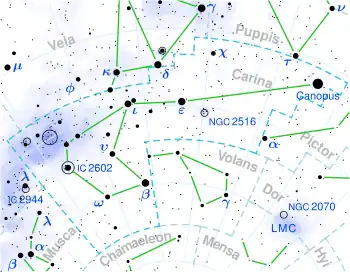DENIS J081730.0−615520
DENIS J081730.0−615520 (also known as 2MASS 08173001−6155158) is a T brown dwarf approximately 16 ly (4.9 pc) away in the constellation Carina. It was discovered by Etienne Artigau and his colleagues in April 2010. The star belongs to the T6 spectral class implying a photosphere temperature of about 950 K. It has a mass of about 15 MJ (Jupiter masses) or about 1.5% the mass of the Sun.[2]
 DENIS J081730.0−615520 Location of DENIS J081730.0−615520 in the constellation Carina | |
| Observation data Epoch J2000 Equinox J2000 | |
|---|---|
| Constellation | Carina |
| Right ascension | 08h 17m 29.99888s[1] |
| Declination | −61° 55′ 15.6586″[1] |
| Characteristics | |
| Spectral type | T6[2] |
| Apparent magnitude (J) | 13.6 |
| J−H color index | 0.087 ± 0.039[2] |
| J−K color index | 0.093 ± 0.049[2] |
| Astrometry | |
| Proper motion (μ) | RA: −156.451±0.507 mas/yr[1] Dec.: 1099.366±0.503 mas/yr[1] |
| Parallax (π) | 191.8362 ± 0.4186 mas[1] |
| Distance | 17.00 ± 0.04 ly (5.21 ± 0.01 pc) |
| Details | |
| Mass | 0.015[2] M☉ |
| Radius | 0.94±0.16[3] RJup |
| Temperature | 950[2] K |
| Rotation | 2.8±0.2 hours |
| Age | 1[3] Gyr |
| Other designations | |
| Database references | |
| SIMBAD | data |
DENIS J081730.0-615520 is the second-nearest isolated T dwarf to the Sun (after UGPS J0722−0540) and the fifth-nearest (also after ε Indi Bab and SCR 1845-6357B) if one takes into account T dwarfs in multiple star systems. It is also the brightest T dwarf in the sky (in the J-band); it had been missed before due to its proximity to the galactic plane.[2]
References
- Vallenari, A.; et al. (Gaia collaboration) (2023). "Gaia Data Release 3. Summary of the content and survey properties". Astronomy and Astrophysics. 674: A1. arXiv:2208.00211. Bibcode:2023A&A...674A...1G. doi:10.1051/0004-6361/202243940. S2CID 244398875. Gaia DR3 record for this source at VizieR.
- Artigau, Etienne; Radigan, Jacqueline; Folkes, Stuart; et al. (2010). "DENIS J081730.0-615520: An overlooked mid-T dwarf in the solar neighborhood". The Astrophysical Journal Letters. 718 (1): L38–L42. arXiv:1006.3577. Bibcode:2010ApJ...718L..38A. doi:10.1088/2041-8205/718/1/L38. S2CID 118687449.
- Vos, Johanna M.; Biller, Beth A.; Allers, Katelyn N.; Faherty, Jacqueline K.; Liu, Michael C.; Metchev, Stanimir; Eriksson, Simon; Manjavacas, Elena; Dupuy, Trent J.; Janson, Markus; Radigan-Hoffman, Jacqueline; Crossfield, Ian; Bonnefoy, Mickaël; Best, William M. J.; Homeier, Derek; Schlieder, Joshua E.; Brandner, Wolfgang; Henning, Thomas; Bonavita, Mariangela; Buenzli, Esther (2020), "Spitzer Variability Properties of Low-gravity L Dwarfs", The Astronomical Journal, 160: 38, arXiv:2005.12854, doi:10.3847/1538-3881/ab9642, S2CID 218889787
- Kirkpatrick, J. Davy; Cushing, Michael C.; Gelino, Christopher R.; Griffith, Roger L.; Skrutskie, Michael F.; Marsh, Kenneth A.; Wright, Edward L.; Mainzer, Amy K.; Eisenhardt, Peter R.; McLean, Ian S.; Thompson, Maggie A.; Bauer, James M.; Benford, Dominic J.; Bridge, Carrie R.; Lake, Sean E.; Petty, Sara M.; Stanford, Spencer Adam; Tsai, Chao-Wei; Bailey, Vanessa; Beichman, Charles A.; Bloom, Joshua S.; Bochanski, John J.; Burgasser, Adam J.; Capak, Peter L.; Cruz, Kelle L.; Hinz, Philip M.; Kartaltepe, Jeyhan S.; Knox, Russell P.; Manohar, Swarnima; Masters, Daniel; Morales-Calderon, Maria; Prato, Lisa A.; Rodigas, Timothy J.; Salvato, Mara; Schurr, Steven D.; Scoville, Nicholas Z.; Simcoe, Robert A.; Stapelfeldt, Karl R.; Stern, Daniel; Stock, Nathan D.; Vacca, William D. (2011). "The First Hundred Brown Dwarfs Discovered by the Wide-field Infrared Survey Explorer (WISE)". The Astrophysical Journal Supplement. 197 (2): 19. arXiv:1108.4677v1. Bibcode:2011ApJS..197...19K. doi:10.1088/0067-0049/197/2/19. S2CID 16850733.
External links
- Astronomers Announce First Clear Evidence of a Brown Dwarf – STScI news release STScI-1995-48 (November 29, 1995)
This article is issued from Wikipedia. The text is licensed under Creative Commons - Attribution - Sharealike. Additional terms may apply for the media files.